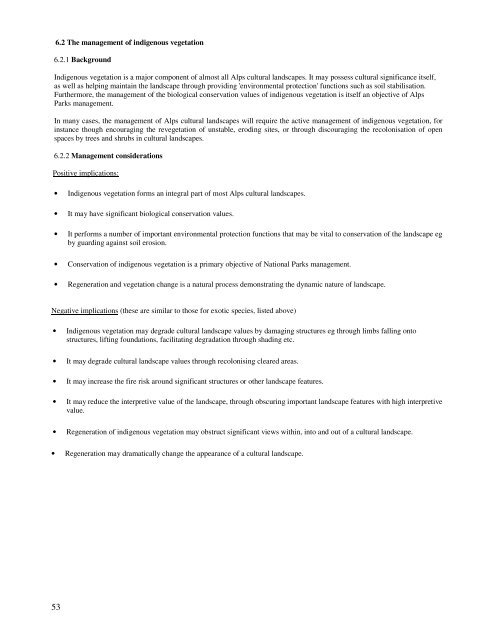Cultural Landscape Management - Australian Alps National Parks
Cultural Landscape Management - Australian Alps National Parks
Cultural Landscape Management - Australian Alps National Parks
You also want an ePaper? Increase the reach of your titles
YUMPU automatically turns print PDFs into web optimized ePapers that Google loves.
6.2 The management of indigenous vegetation6.2.1 BackgroundIndigenous vegetation is a major component of almost all <strong>Alps</strong> cultural landscapes. It may possess cultural significance itself,as well as helping maintain the landscape through providing 'environmental protection' functions such as soil stabilisation.Furthermore, the management of the biological conservation values of indigenous vegetation is itself an objective of <strong>Alps</strong><strong>Parks</strong> management.In many cases, the management of <strong>Alps</strong> cultural landscapes will require the active management of indigenous vegetation, forinstance though encouraging the revegetation of unstable, eroding sites, or through discouraging the recolonisation of openspaces by trees and shrubs in cultural landscapes.6.2.2 <strong>Management</strong> considerationsPositive implications:• Indigenous vegetation forms an integral part of most <strong>Alps</strong> cultural landscapes.• It may have significant biological conservation values.• It performs a number of important environmental protection functions that may be vital to conservation of the landscape egby guarding against soil erosion.• Conservation of indigenous vegetation is a primary objective of <strong>National</strong> <strong>Parks</strong> management.• Regeneration and vegetation change is a natural process demonstrating the dynamic nature of landscape.Negative implications (these are similar to those for exotic species, listed above)• Indigenous vegetation may degrade cultural landscape values by damaging structures eg through limbs falling ontostructures, lifting foundations, facilitating degradation through shading etc.• It may degrade cultural landscape values through recolonising cleared areas.• It may increase the fire risk around significant structures or other landscape features.• It may reduce the interpretive value of the landscape, through obscuring important landscape features with high interpretivevalue.• Regeneration of indigenous vegetation may obstruct significant views within, into and out of a cultural landscape.• Regeneration may dramatically change the appearance of a cultural landscape.53
















